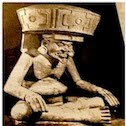So back to our original symbols of yore, were they more accurate in spite of being forbidden to use the symbols they understood at the time of a special sky event?
Once upon a time, the Popol Vuh contained a turtle which hung over the ball court. Xabalenque tossed a stone at the carapace and shattered it into many pieces. There were so many pieces that it was more likely meant to be the word for squash [q'oq] a scattering of seeds.1
Note for p. 127 on p. 276: "the word used for the coati was [coc] which must be q’oq’, squash, rather than "Ko’k," turtle. Obviously turtles do not have seeds," [So the text was adjusted] Dennis Tedlock (1996, 127)
Regardless of whether the turtle as "k'ok" with a shattered carapace or the subsequent "squash," "q'oq" [or c'oc] that actually contains many seeds. one must ask why the event used a turtle as its original explanation. What was the event that would justify the use of a turtle shell as its symbol in its description?
What was perfectly obvious, who from eating or reading about both, the differences between turtles and squash is not feasible to use the same points of book references or eating as a person who has lived with the symbolic language of his community all of his life. To assume that one word is better than another, one must consider the reason behind the symbolism and what it infers. Infer, is a must, because no proper explanation was requested.
_______________
At times, the symbol of a god was different, with a different name, or even in a different social situation. In Maya, the Maize god's main attribute was his association with the Sun God at the time of Creation. Later, the Maize God took precedence over the Sun God for a time; However, in the beginning music was one of the basic attributes of the blazing, burning "Sun" god, just as it was in Rome or in Athens. again with different names and different attributes; i.e. Apollo, the sun or Hermes, he who defeated the musical ability of the sun. (But do not forget that Apollo's son was a catalyst in the Greek story later.)
Still another attribute was the re-birth of the Maize God or his resurrection from the dead via the turtle carapace thought to be the Earth, together with his ability to save people from starvation, (See previous post) hence the turtle's reference to being a food carrier in the sky ball game scenario.
So, with the various references to the turtle below, one can see that music was the first (maybe) reference to the turtle. In the Popol Vuh, it was only a replacement for a head and later a shell hung over the ball court to be smashed by a stone thrown by Xbalenque.
The Turtle was once an important constellation that was finally called Lyra. Greek and Roman texts took precedence over ancient astronomy and that is perfectly correct, at times. Before the second game, the head of Hunahpú was lost to the bats, and a replacement had to be devised. So it was a star within the Turtle constellation (Lyra) exploded, making the Twins the most colorful comets in the sky. [It is similar to Christmas Pine Cones when they are soaked in metallic chemicals and flit in the fireplaces for a colorful Treat for the Holidays.]
It is interesting that the turtle was removed from any reference to astronomy, long before it was removed from the Popol Vuh. So there can be no fault in translations, since other governments had already done the dastardly deed.
1 (1954, 107) Popul Vuh “The Book of the People” Translated into English by Delia Goetz and Sylvanus Griswold
Morley, from Adrián Recino's translation from Quiché into Spanish Plantin Press, Los Angeles [1954, copyright not
registered or renewed]
"…Presently Xbalanqué threw a stone at the turtle, which came to the ground and fell in the ballcourt, breaking into
a thousand pieces like seeds, before the lords.…"
________________________________
Here are only a few of Justin Kerr's Vase examples of the Maize God's connection with the turtle as his earth (in the sky) and with our physical Earth when he was reborn. They include, music, the turtle source of music, the turtle source of birth in or on the earth; One Hunahpú, the father of the Twins who gave him his "bone throne"; the presence of Seven Macaw; pieces of the turtle shell floating through the primordial sea in the sky; and a hazy ideaograph of his monkey association with the northwestern skies.
Kerr Number: K-118 Music, and K-645 Musicians sleep and watch with infant in sacrificial cache vessel and K-4998 Resurrection of Hun Hun Ahpu from quatrefoil turtle carapace, with deer impersonator for a dance ceremony
Kerr Number: K-4681 The maize god being reborn (resurrected) from the turtle shell with the aid of his sons, the hero twins. Also K-8757 Maize God in watery realm (turtles on each side maybe) and K-9174 The resurrection scene with the Maize God holding a bird. God N emerges from the turtle shell as inK-2980 God N in Turtle Carapace
Kerr Number: K-728 Wtater lily monster as skeletal god with turtle carapace for body holding bone throne over his head and K-4539 supernatural turtles? swimming through the primordial sea
Kerr Number: K-5457 Turtle on cover of vessel. Its abstract designs seem to be monkeys.
